Apple's very strange A12X microprocessor casing
- Transfer
In the advertising video of the new iPad Pro, shown in October, there is a sequence of frames in which the tablet is assembled from components. Being a great lover of picking up electronics, I took pictures from a video clip showing the filling of the motherboard with components, and here is one of them:
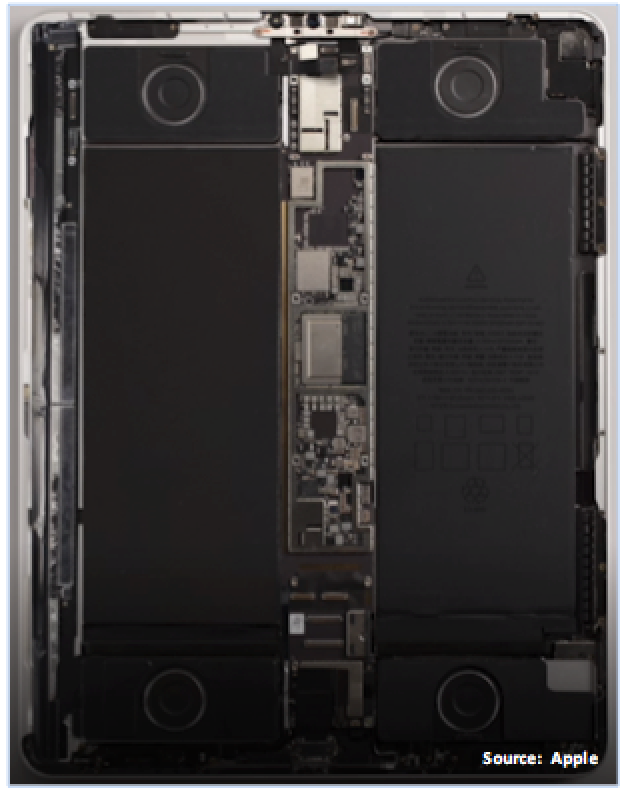
In the center, presumably, is A12X ; however, it looks like a half-case, next to which there are perhaps a couple of DRAM cases. Increase and get the following:

The image is pixelated, but looks like a half BGA case with a metal cover, next to which there are two DRAM cases. There is no A12X marking, but the iPad Pro usually uses BGA with a lid for AX series chips, and the cases next to it look real, very similar to Micron DRAM - although this is all rather unintelligible.
Since it all looked like another innovation in the field of microprocessor housings from Apple, without any public announcements, as is usually the case, and since it was just a promotional video from a product launch that may differ from reality, I kept my reasoning myself, until TechInsights did a review with analysis.

They confirmed that what was shown in the video is an unusual case from the A12X.
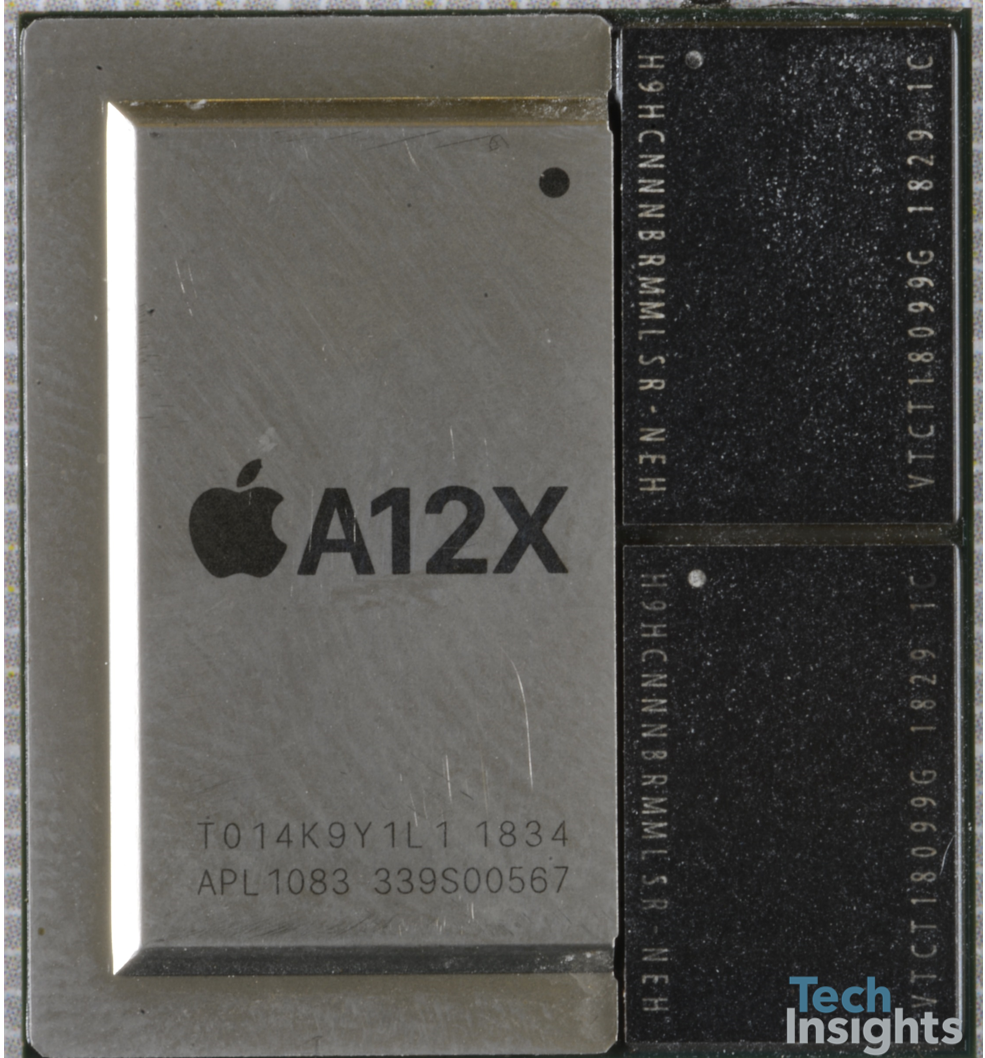
Upon closer inspection, you can see the presence of two SK Hynix LPDDR4 DRAMs (H9HCNNNBRMMLSR-NEH, in the amount of 4 GB) next to the BGA case with a cover on a specially made substrate, mounted on the motherboard.

The dimensions of the case are 23.8 x 26.3 mm.
They also removed the assembly from the motherboard, and now we can take a look at the base.
Out of interest, I looked at the disassembly from iFixit , and the boards look exactly the same, but in their version there was Micron DRAM (Micron MT53D256M64D4KA, 4 GB) along with A12X, which reflects the presence of various memory vendors from Apple. In both cases 2 x 16 GB are used, which can be 2 crystals of 8 GB each or, possibly, 4 x 4 GB.
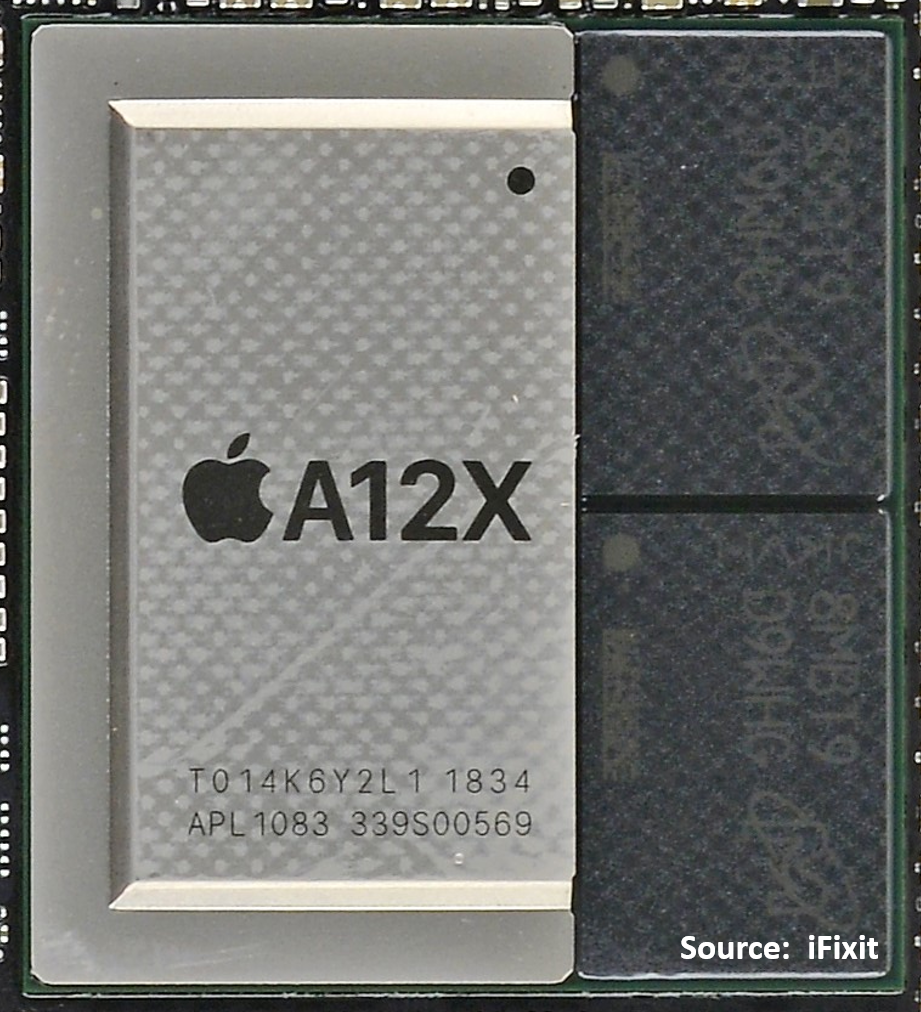
You can see that the two parts of the A12X have the same APL1083 number and even one date code of 1834, but the more detailed device numbers are slightly different - the instance from TechInsights is 339S00567, and the iFixit has 339S00569.
TechInsights also took an X-ray and the shadow of the thermal interface (silicon is almost transparent for X-rays) gives us an approximate crystal size of ~ 10.4 x 13.0 m (~ 135 mm 2 ). Under the cover, apparently, there are passive ceramic components, and, most likely, four silicon capacitors on the substrate. Although X-ray confirms the presence of three cases on a common substrate, it is rather strange that BGA does not have solder balls.
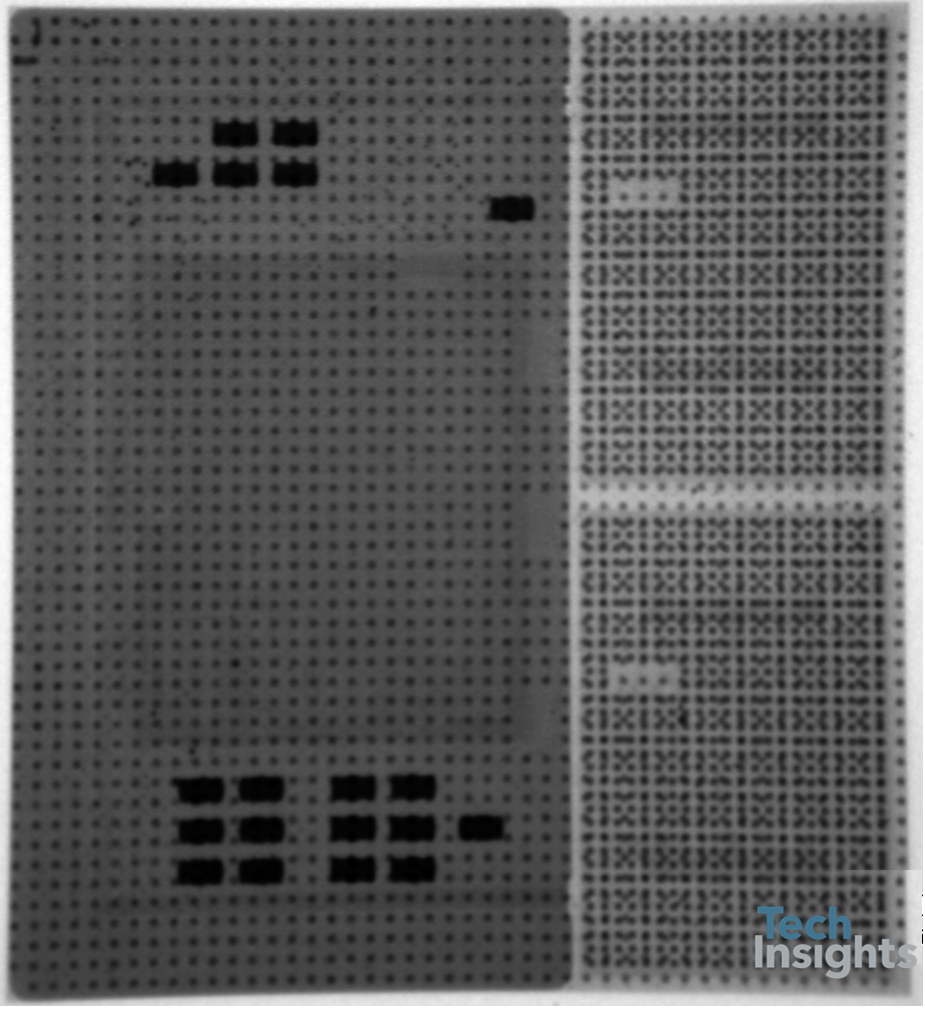
DRAM cases clearly demonstrate a solder pattern merging with the substrate; but there is no such thing under the Apple chip. I can think of a couple of reasons for this: the A12X case has the same ball grid as the substrate (unlikely); This is really a BGA with a cover, a flip-chip connected to the technology with a substrate under the cropped metal cover, and next to it is installed a FBGA memory.
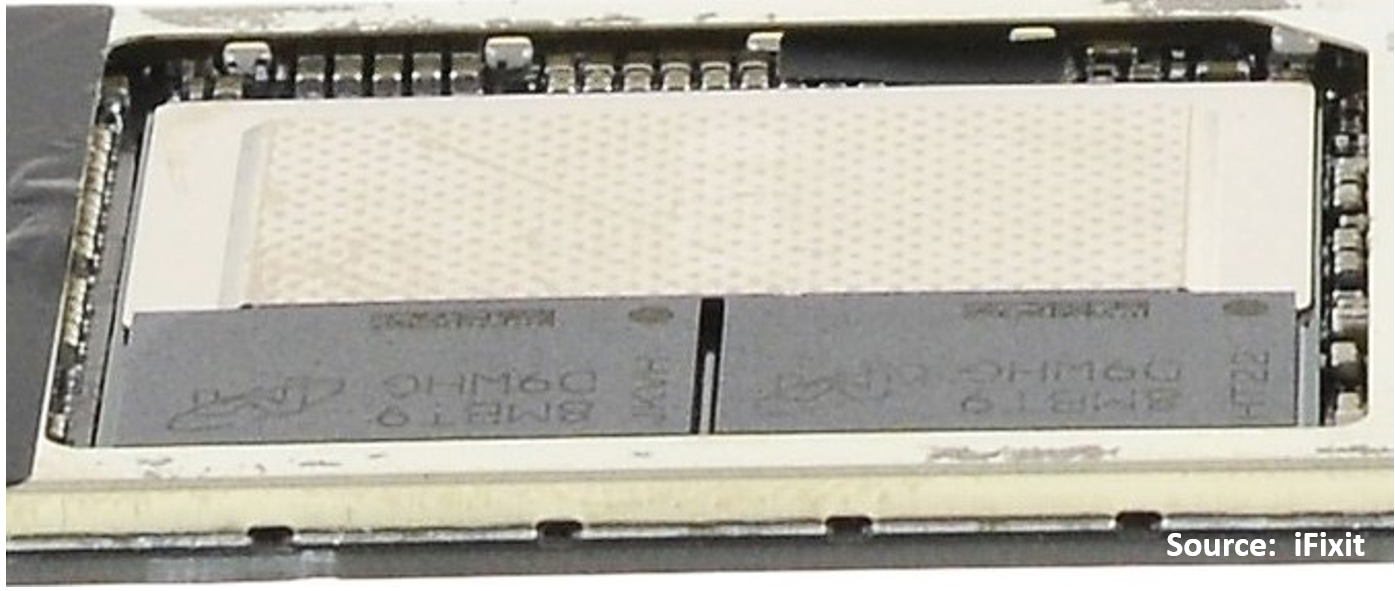
Judging by the photo above, taken in perspective, the last option will be correct. In the foreground, Micron DRAM is visible, and the A12X case cover is located directly on the substrate, as in a standard BGA case with a cover.
In mobile phones, DRAM and the processor are located in the package-on-package (PoP) configuration from the very first iPhone - this saves space and reduces delays in communication between the processor and memory. Heat is radiated relatively little, so heat transfer with a vertical arrangement of buildings does not pose a problem. In tablets, they emit more heat, and space is not so critical, so processors usually have a case with a lid, and DRAM is located nearby on the motherboard. The following photo of the A10X system shows what I mean.
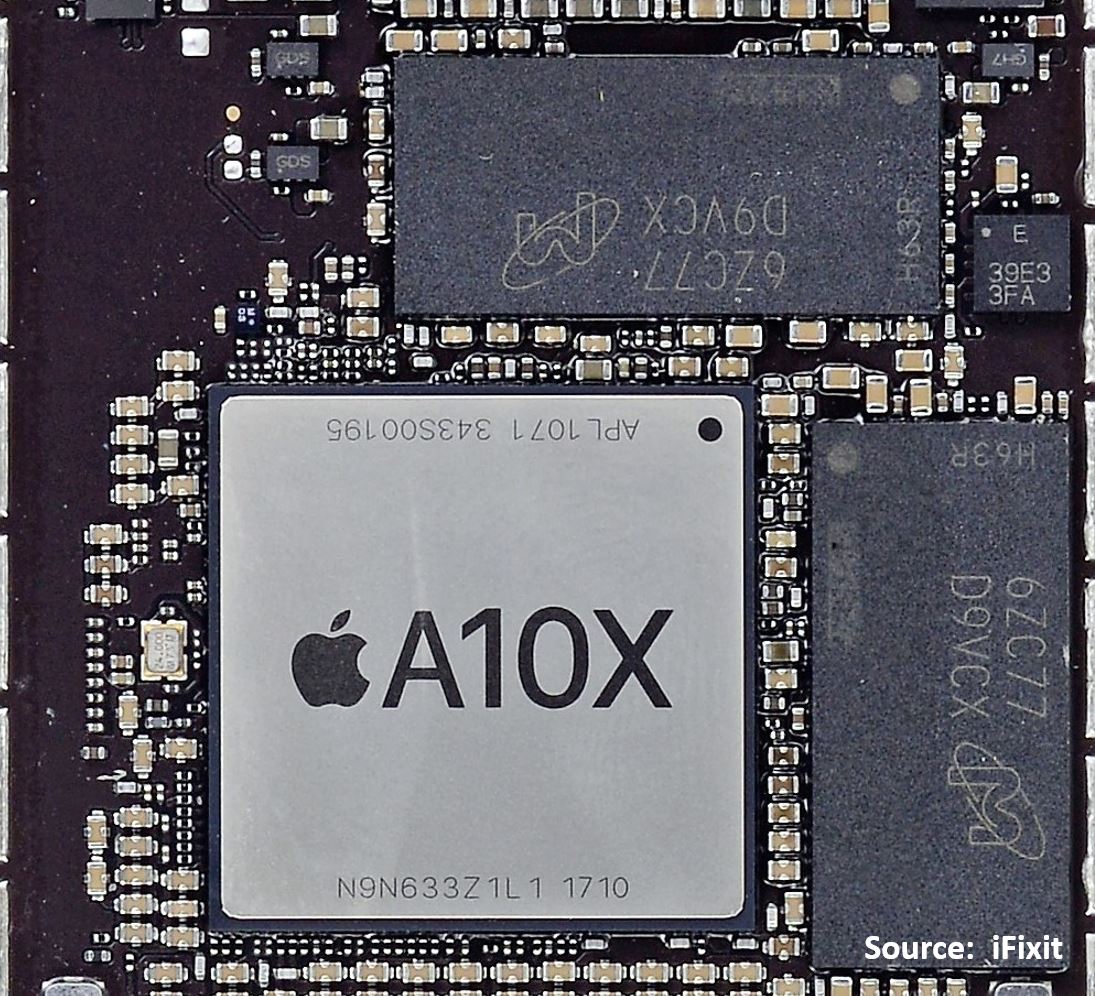
However, in this situation, the memory access delays should be longer, and in this context, we expect that the memory will be on the same substrate using the flip-chip system. Although I personally expected to first see a location in the phone where it would help reduce the height of the case.
This would have been a 2.5D-type case, but for Apple, silicon interposer technology or Intel's EMIB would most likely be too expensive. Organic interpozers are cheaper, but technology is still too young for commercial use.
And here is a compromise - they took a BGA with a lid, cut off half of the lid, and placed the memory cases on the same substrate from BGA. Advantages - good heat dissipation and close proximity of the memory to the processor, and also, probably, the cheapest option. A memory flip chip on a substrate for a model with 4 GB would most likely require two crystals of 16 GB each, which, if they were, would have cost more.
To find out what is really going on, you will have to wait until one of the analytics companies shows us a slice. So we were right - and got another innovative microprocessor case from Apple!

In the center, presumably, is A12X ; however, it looks like a half-case, next to which there are perhaps a couple of DRAM cases. Increase and get the following:

The image is pixelated, but looks like a half BGA case with a metal cover, next to which there are two DRAM cases. There is no A12X marking, but the iPad Pro usually uses BGA with a lid for AX series chips, and the cases next to it look real, very similar to Micron DRAM - although this is all rather unintelligible.
Since it all looked like another innovation in the field of microprocessor housings from Apple, without any public announcements, as is usually the case, and since it was just a promotional video from a product launch that may differ from reality, I kept my reasoning myself, until TechInsights did a review with analysis.

They confirmed that what was shown in the video is an unusual case from the A12X.

Upon closer inspection, you can see the presence of two SK Hynix LPDDR4 DRAMs (H9HCNNNBRMMLSR-NEH, in the amount of 4 GB) next to the BGA case with a cover on a specially made substrate, mounted on the motherboard.

The dimensions of the case are 23.8 x 26.3 mm.
They also removed the assembly from the motherboard, and now we can take a look at the base.
Out of interest, I looked at the disassembly from iFixit , and the boards look exactly the same, but in their version there was Micron DRAM (Micron MT53D256M64D4KA, 4 GB) along with A12X, which reflects the presence of various memory vendors from Apple. In both cases 2 x 16 GB are used, which can be 2 crystals of 8 GB each or, possibly, 4 x 4 GB.

You can see that the two parts of the A12X have the same APL1083 number and even one date code of 1834, but the more detailed device numbers are slightly different - the instance from TechInsights is 339S00567, and the iFixit has 339S00569.
TechInsights also took an X-ray and the shadow of the thermal interface (silicon is almost transparent for X-rays) gives us an approximate crystal size of ~ 10.4 x 13.0 m (~ 135 mm 2 ). Under the cover, apparently, there are passive ceramic components, and, most likely, four silicon capacitors on the substrate. Although X-ray confirms the presence of three cases on a common substrate, it is rather strange that BGA does not have solder balls.

DRAM cases clearly demonstrate a solder pattern merging with the substrate; but there is no such thing under the Apple chip. I can think of a couple of reasons for this: the A12X case has the same ball grid as the substrate (unlikely); This is really a BGA with a cover, a flip-chip connected to the technology with a substrate under the cropped metal cover, and next to it is installed a FBGA memory.

Judging by the photo above, taken in perspective, the last option will be correct. In the foreground, Micron DRAM is visible, and the A12X case cover is located directly on the substrate, as in a standard BGA case with a cover.
In mobile phones, DRAM and the processor are located in the package-on-package (PoP) configuration from the very first iPhone - this saves space and reduces delays in communication between the processor and memory. Heat is radiated relatively little, so heat transfer with a vertical arrangement of buildings does not pose a problem. In tablets, they emit more heat, and space is not so critical, so processors usually have a case with a lid, and DRAM is located nearby on the motherboard. The following photo of the A10X system shows what I mean.

However, in this situation, the memory access delays should be longer, and in this context, we expect that the memory will be on the same substrate using the flip-chip system. Although I personally expected to first see a location in the phone where it would help reduce the height of the case.
This would have been a 2.5D-type case, but for Apple, silicon interposer technology or Intel's EMIB would most likely be too expensive. Organic interpozers are cheaper, but technology is still too young for commercial use.
And here is a compromise - they took a BGA with a lid, cut off half of the lid, and placed the memory cases on the same substrate from BGA. Advantages - good heat dissipation and close proximity of the memory to the processor, and also, probably, the cheapest option. A memory flip chip on a substrate for a model with 4 GB would most likely require two crystals of 16 GB each, which, if they were, would have cost more.
To find out what is really going on, you will have to wait until one of the analytics companies shows us a slice. So we were right - and got another innovative microprocessor case from Apple!
